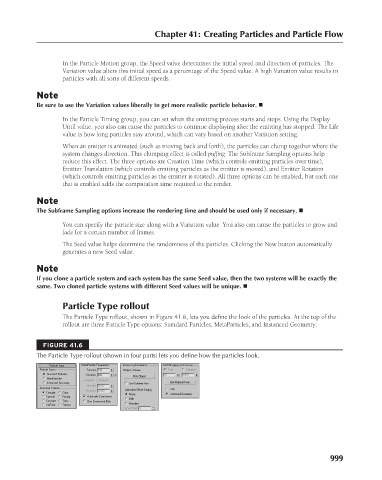Page 1047 - Kitab3DsMax
P. 1047
Chapter 41: Creating Particles and Particle Flow
In the Particle Motion group, the Speed value determines the initial speed and direction of particles. The
Variation value alters this initial speed as a percentage of the Speed value. A high Variation value results in
particles with all sorts of different speeds.
Note
Be sure to use the Variation values liberally to get more realistic particle behavior. n
In the Particle Timing group, you can set when the emitting process starts and stops. Using the Display
Until value, you also can cause the particles to continue displaying after the emitting has stopped. The Life
value is how long particles stay around, which can vary based on another Variation setting.
When an emitter is animated (such as moving back and forth), the particles can clump together where the
system changes direction. This clumping effect is called puffing. The Subframe Sampling options help
reduce this effect. The three options are Creation Time (which controls emitting particles over time),
Emitter Translation (which controls emitting particles as the emitter is moved), and Emitter Rotation
(which controls emitting particles as the emitter is rotated). All three options can be enabled, but each one
that is enabled adds the computation time required to the render.
Note
The Subframe Sampling options increase the rendering time and should be used only if necessary. n
You can specify the particle size along with a Variation value. You also can cause the particles to grow and
fade for a certain number of frames.
The Seed value helps determine the randomness of the particles. Clicking the New button automatically
generates a new Seed value.
Note
If you clone a particle system and each system has the same Seed value, then the two systems will be exactly the
same. Two cloned particle systems with different Seed values will be unique. n
Particle Type rollout
The Particle Type rollout, shown in Figure 41.6, lets you define the look of the particles. At the top of the
rollout are three Particle Type options: Standard Particles, MetaParticles, and Instanced Geometry.
FIGURE 41.6
The Particle Type rollout (shown in four parts) lets you define how the particles look.
999

